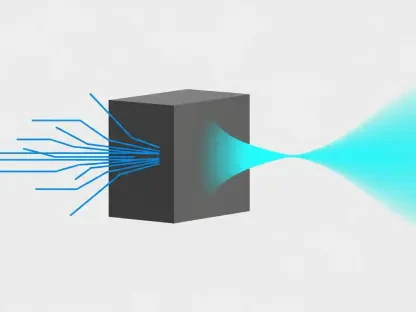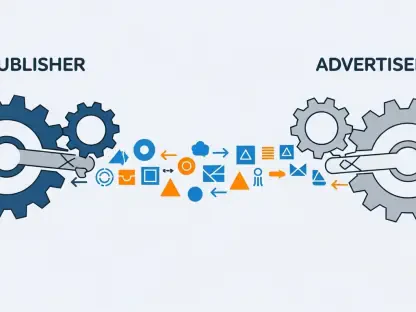In a telecommunications landscape increasingly defined by rapid technological shifts and fierce competition, Nokia, the Finnish giant, finds itself at a critical juncture with declining sales and a shrinking foothold in the vital US market, reporting a 6% sales drop to $6.2 billion in the first nine months of the year and a staggering shift from profit to a $75 million loss. This financial downturn, compounded by the loss of significant contracts like the one with AT&T, has left Nokia heavily reliant on T-Mobile as its primary US customer. Amid this backdrop of struggle, a potential lifeline has emerged through a strategic partnership with Nvidia, an American chipmaker renowned for its powerful graphics processing units (GPUs). With a $1 billion investment for a 2.9% stake in Nokia, Nvidia’s involvement signals more than just financial backing—it hints at a transformative integration of cutting-edge GPU technology into Nokia’s radio access network (RAN) products for 5G and 6G networks. This alliance, spearheaded by Nokia’s new American CEO, Justin Hotard, places a bold bet on artificial intelligence (AI) in telecom, often referred to as AI-RAN, envisioning a future where AI-driven devices demand unprecedented network capabilities. The stakes are high, and the industry watches closely to see if this collaboration can reverse Nokia’s fortunes or if it’s a risky overreach in an uncertain market.
The Strategic Pivot to AI-RAN
Nokia’s Challenges and the Need for Innovation
Nokia’s recent financial performance paints a grim picture, with a significant sales decline and a shift from operating profit to substantial loss, underscoring the urgent need for a strategic overhaul. The erosion of market share in the US, particularly after losing key contracts, has diminished Nokia’s standing in one of the most lucrative RAN markets globally. This precarious position has pushed the company to explore innovative pathways to regain competitiveness. The partnership with Nvidia emerges as a calculated, albeit desperate, move to leverage AI-RAN as a means to address operational inefficiencies and recapture lost ground. By integrating Nvidia’s GPU technology, Nokia aims to redefine its offerings for 5G and 6G networks, hoping to position itself as a leader in the next wave of telecom advancements. The financial backing from Nvidia mitigates some immediate risks, providing a cushion to experiment with unproven technologies in a highly competitive sector.
Under the stewardship of Justin Hotard, who assumed the CEO role with a background from Intel and HPE, Nokia is embracing a vision of an “AI supercycle” that could transform mobile networks. Hotard’s belief in the convergence of AI and connectivity—envisioning devices like smart glasses and autonomous vehicles driving unprecedented network demands—marks a significant departure from Nokia’s earlier reluctance to adopt Nvidia’s GPUs in favor of a pre-existing partnership with Marvell Technology. This strategic pivot is not merely about adopting new hardware; it’s about reimagining how networks can operate with machine learning replacing traditional algorithms. The challenge lies in executing this vision amidst financial constraints and a skeptical industry, where Nokia must prove that AI-RAN is not just a buzzword but a viable solution to real-world telecom problems. Hotard’s leadership will be tested as he navigates these complexities to steer Nokia toward recovery.
Financial Stakes and Strategic Implications
The $1 billion investment by Nvidia, securing a 2.9% stake in Nokia, represents more than a financial transaction; it’s a strategic alignment aimed at reshaping the telecom landscape. For Nvidia, the RAN market, though smaller at $35 billion annually compared to the sprawling data center sector, offers a unique opportunity to extend GPU deployment into telecom facilities, reducing latency for AI applications by placing computing power closer to end users. This move aligns with Nvidia’s broader strategy of fostering ecosystems reliant on its technology, as seen in prior investments in entities like OpenAI and Intel. For Nokia, this partnership provides a much-needed infusion of capital and technological expertise at a time when its mobile networks business is floundering. However, this alliance also raises questions about potential dependency on Nvidia, as Nokia adapts its 5G and 6G software to run on GPUs, potentially sidelining existing collaborations with Marvell Technology.
Beyond the immediate financial relief, the partnership carries significant implications for Nokia’s competitive positioning and long-term strategy in the telecom industry. The integration of GPU technology into RAN products could set Nokia apart as a pioneer in AI-driven networks, provided it can overcome industry skepticism and demonstrate tangible benefits. Yet, the geopolitical undertones of this deal add another layer of complexity, with promotional materials emphasizing American leadership in 5G and 6G, somewhat overshadowing Nokia’s Finnish heritage. This subtle shift in narrative under Hotard’s American-centric leadership may stir tensions regarding the alignment of global interests. As Nokia navigates this high-stakes gamble, the balance between innovation, financial stability, and international identity will be crucial in determining whether this partnership can truly serve as a catalyst for revival or if it risks entrenching new vulnerabilities.
Industry Reception and Technological Debate
Skepticism from Telcos and Competitors
The ambitious push for AI-RAN through the Nokia-Nvidia partnership has met with considerable doubt from key players in the telecom industry, casting uncertainty over its potential success. Major telcos such as Verizon and Orange have openly questioned the necessity of integrating GPUs into RAN infrastructure, arguing that there is no compelling business case to justify the additional costs and complexity. Their reluctance stems from a broader industry caution toward adopting unproven technologies, especially in an era where revenue growth remains elusive for many operators. This skepticism is not just a hurdle but a fundamental challenge for Nokia, as convincing these influential customers of AI-RAN’s value proposition will be essential to gaining traction. Without widespread telco buy-in, the partnership risks being seen as an expensive experiment rather than a transformative solution.
Adding to the chorus of doubt, Nokia’s primary competitor, Ericsson, has taken a measured stance on the role of GPUs in RAN, acknowledging the importance of AI in network optimization but dismissing the immediate need for such hardware. Ericsson’s perspective highlights potential drawbacks, including the risk of technological lock-in with Nvidia’s ecosystem, which could limit flexibility for operators down the line. This competitive resistance underscores a divide within the industry about how best to integrate AI into telecom networks. While Nokia bets on GPUs as the future, others advocate for alternative approaches using existing custom silicon or general-purpose processors. The clash of viewpoints suggests that Nokia’s path forward will require not only technological innovation but also a robust strategy to address these concerns and shift industry perceptions about the practical benefits of AI-RAN.
Customer Dynamics and Market Realities
The hesitancy of telco customers to embrace AI-RAN is deeply rooted in the economic realities of the telecom sector, where stagnant revenue growth limits appetite for significant infrastructure investments. Unlike data center clients who often see rapid expansion and returns, telcos face a more constrained financial environment, making them wary of adopting costly new technologies like GPUs without clear evidence of payoff. Forecasts indicate that telecom revenues are expected to grow at a modest compound annual rate of just 2.7% through 2030, with RAN product revenues remaining largely flat. This sobering outlook challenges the economic rationale behind Nokia’s ambitious plans, as operators prioritize cost efficiency over speculative innovation. For Nokia, overcoming this barrier means demonstrating that AI-RAN can deliver measurable improvements in network performance or operational savings that justify the expense.
Further complicating the landscape, industry bodies like the Next Generation Mobile Networks Alliance (NGMN) advocate for 6G as an evolutionary step from 5G, achievable primarily through software upgrades rather than extensive hardware overhauls. This perspective aligns with the broader telco preference for minimizing capital expenditure while still advancing network capabilities. Nokia’s focus on GPU integration thus appears somewhat at odds with this trend, positioning AI-RAN as a harder sell to a market focused on incremental, cost-effective progress. The upcoming field trials with T-Mobile, planned to start soon with a potential commercial rollout by 2027, will be a critical test of whether Nokia can bridge this gap. Success in these trials could provide the proof of concept needed to sway skeptical customers, but failure might reinforce the industry’s reservations, leaving Nokia to grapple with the fallout of an unconvincing value proposition.
Looking Ahead: Risks and Opportunities
Testing Ground with T-Mobile
The partnership between Nokia and Nvidia faces a pivotal moment with T-Mobile, Nokia’s primary US customer, set to conduct field trials for AI-RAN starting soon, eyeing a commercial rollout by 2027. This trial phase represents a make-or-break opportunity for Nokia to validate its vision of AI-driven networks in a real-world setting. A successful deployment could position Nokia as a disruptive force in mobile technology, reminiscent of the transformative impact the iPhone had on the industry years ago. Demonstrating that AI-RAN can enhance network efficiency, reduce latency, and support emerging AI applications would provide a powerful case to win over other telcos. T-Mobile’s involvement, given its significant market presence, adds weight to the potential ripple effects of a positive outcome, possibly shifting industry perceptions and encouraging broader adoption of Nokia’s technology.
However, the road to success is fraught with challenges, as customer indifference remains a substantial risk that could undermine even the most promising trial results. Telcos, burdened by tight budgets and a focus on short-term returns, may remain unmoved by technological advancements if immediate financial benefits aren’t evident. Additionally, competitive pushback from Ericsson, which continues to advocate for alternative AI integration methods, could dilute Nokia’s momentum. The speculative nature of the AI market itself poses another threat, as overreliance on hype could lead to disillusionment if expectations outpace reality. Nokia must navigate these uncertainties with a clear strategy to highlight AI-RAN’s practical advantages, ensuring that the T-Mobile trials serve as a compelling proof point rather than a missed opportunity in a crowded and cautious market.
Balancing Innovation with Market Risks
Reflecting on the broader implications, the Nokia-Nvidia alliance unfolds as a bold attempt to redefine telecom through AI, but it is met with a complex mix of potential and peril that demands careful consideration. The integration of GPUs into RAN infrastructure promises to usher in a new era of network capabilities, yet the industry’s tepid response underscores the difficulty of pushing untested technologies in a cost-conscious sector. Nokia’s leadership must weigh the transformative possibilities against the tangible risks of market rejection and competitive dynamics that shape the partnership’s trajectory. The geopolitical framing of the deal, with its emphasis on American leadership, also introduces subtle tensions for a company rooted in European heritage, complicating its global positioning.
Looking to the future, Nokia needs to focus on actionable steps to mitigate these risks, prioritizing robust data from trials to build a convincing case for AI-RAN’s benefits. Cultivating strategic dialogues with skeptical telcos to address their concerns about cost and dependency is essential, as is exploring hybrid solutions that can balance innovation with existing technologies. Monitoring the broader AI market for signs of overvaluation or shifts in investment trends becomes critical to avoid being caught off-guard by a potential downturn. Ultimately, the journey ahead requires Nokia to not only innovate but also adapt to industry feedback, ensuring that its ambitious partnership with Nvidia evolves into a sustainable model for growth rather than a fleeting experiment in an ever-changing telecom landscape.









